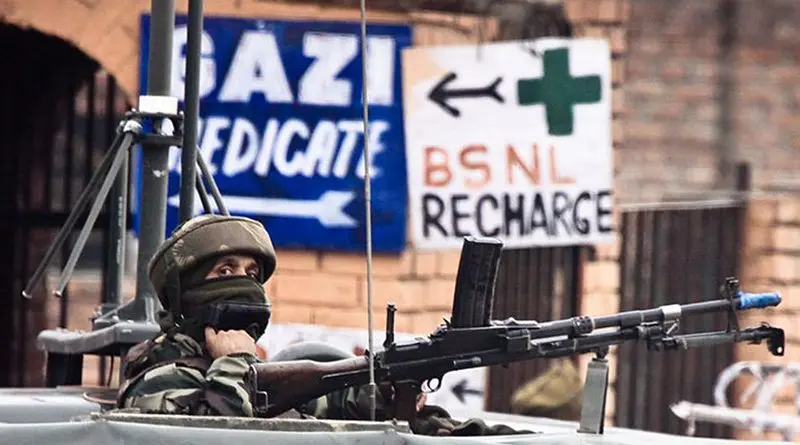Jammu And Kashmir: The BJP-PDP Break Up – Analysis
By IPCS
By Sarral Sharma*
On 19 June, the Bharatiya Janata Party (BJP) ended its three-year old alliance with the Jammu and Kashmir Peoples Democratic Party (PDP) in Jammu and Kashmir (J&K), resulting in the collapse of the coalition government. Indian President Ram Nath Kovind has approved the imposition of Governor’s rule in the state for next six months. Under the Governor’s rule, the BJP-ruled central government in New Delhi may undertake a more hardline security-centric approach with increased counter-insurgency operations to control the scourge of militancy and to create a conducive security environment to conduct upcoming elections in the state. The decision to pull out may favour the BJP politically ahead of the 2019 general elections in India. However, the PDP will face the most challenging task of developing workable outreach initiatives in its core political constituency, South Kashmir, which witnessed mass unrests in the aftermath of the July 2016 killing of Hizbul Mujahideen (HM) Commander, Burhan Wani.
Context
The breakup of the alliance was inevitable and was unsurprising given how the PDP-BJP coalition government failed to improve the law and order situation in the Kashmir Valley after the Wani encounter. Spiralling violence, growing local militancy and radicalisation, delayed Panchayat and local body elections, inter-regional differences between Jammu and Kashmir, and unsuccessful outreach attempts to the separatist leaders were some of the obvious reasons for this long anticipated breakup.
In a press statement announcing the split, the BJP’s J&K in-charge, Ram Madhav, said it had become “untenable” for BJP to continue the alliance with PDP. He stated that “after taking stock of the situation in the state, the central government and central party is of the view that we should leave the government,” referring to factors such as the deteriorating security situation, and the “perceptible sense of discrimination” in its electorally significant regions of Jammu and Ladakh.
For BJP, the decision is an attempt to consolidate its political support, and also to retrieve lost ground in the Jammu region, especially after the fallout post the Kathua rape-and-murder incident earlier this year, which had resulted in the expulsion of the two BJP ministers from the J&K cabinet over their alleged support to the accused persons. But, breaking the alliance over the Kathua incident could have damaged the BJP’s credentials in the rest of the country. Evidently, they waited for an opportune moment.
Differences between BJP and PDP over the extension of the ‘ceasefire’/”suspension of operations” in the Kashmir Valley during the Ramzan month provided a fresh opportunity. While the PDP was in favour of extending the ‘ceasefire’/”suspension of operations,” BJP rejected it possibly due to the following reasons: the Hurriyat leadership had declined to talk; militants continued attacks against civilians and security forces; and ceasefire violations and infiltration attempts from the Pakistani side increased that month. Moreover, on the issue of Ramzan ‘ceasefire’/”suspension of operations,” Madhav said it was not reciprocated by the separatist leaders and militant groups.
What Next?
Given the severely deteriorating law and order situation in the Valley over the past two years, the upcoming Amarnath Yatra could have presented more challenges to the PDP-BJP coalition government. A militant attack on the pilgrims would have been a huge embarrassment for the BJP government in New Delhi ahead of the crucial 2019 general elections. Now, under the Governor’s rule, guided by the BJP-ruled Centre, the security forces will have more freedom and better inter-agency coordination in launching operations against militants in the Valley.
Moreover, in the absence of a democratically-elected government in the state, the governor will head the Unified Command (UC) in J&K – comprised of the Indian Army, Border Security Force, the Central Reserve Police Force, and the state police. This could mean that political sensitivities may not influence decision-making on security operations in the hinterland, especially in districts in South Kashmir such as Pulwama, Shopian, Anantnag and Kulgam.
NN Vohra, the governor of J&K, and Dineshwar Sharma, the interlocutor appointed by New Delhi, will have a crucial role to play in the coming months, including on matters such as: improving intra-regional coordination between Jammu, Ladakh and Kashmir regions; bridging the gap between the Centre and J&K; and provision of humanitarian assistance to areas in the Valley that are most affected by militancy.
In the coming weeks, the most challenging task for the governor would be to create a secure environment to conduct three crucial elections scheduled in the state: Assembly, Panchayat, and the Anantnag bye-poll.
Now that the alliance has ended, the BJP may again rake up J&K-specific issues such as the constitutional validity of Article 35A or the debate over Kashmir’s special status under Article 370 in the run up to the 2019 elections. On the other hand, PDP may have to start from the scratch to rebuild its traditional image of a “soft separatist” party in Kashmir. Additionally, although it seems unlikely at the moment, the PDP’s ‘old guard’ may consider either deserting or choosing a new party leader for future elections in J&K.
*Sarral Sharma
Researcher, Centre for Internal and Regional Security (IReS)

